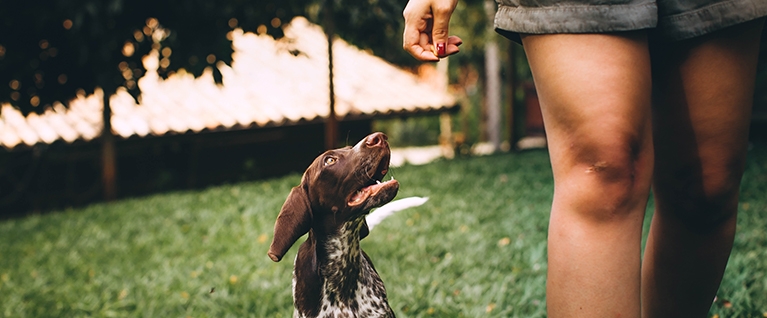When using treats to train your dog, it is important to know that not all cookies are created equal. Your dog will find some treats more interesting and reinforcing than others. You can discover their favorites by offering a variety of snacks and observing their preferences. Functional training treats should follow Smartypaws 5 S’s of successful training treats: small, soft, smelly, satisfying, and safe.
Small: When training a new skill, a high rate of reinforcement (ie: delivering a lot of treats at the right times) is needed to see that behavior repeated. We do not want our pups to get full on treats or experience gastro-intestinal upset. Tiny morsels prevent this problem.
Soft: The soft stuff is more enjoyable and goes down the hatch quickly, so training is not stalled every time you treat. Dry, crunchy biscuits take too long to consume and leave your pup wanting to head for the water bowl.
Smelly: Stinky things capture the interest of most dogs. If it smells amazing to them, then they are likely to work quite hard to get it.
Satisfying: Your training treats should produce pleasure or contentment and provide what is wanted by your dog. A fulfilling treat will cause your pup to want to repeat the behavior you reinforced. If you give them a cookie for laying down on their mat and they spit that cookie out, then your dog will not have any extra inclination to lay down on their mat again. However, tossing a meaty morsel to their mat after they lay down will likely pique their interest in figuring out what they can do to get that fantastic food flying their way again.
Safe: Be sure that your treats are safe for canine consumption. This means different things to different people, but most importantly avoid items like grapes, raisins, nuts, etc. that are toxic to dogs.
Remember the above criteria when presenting your dogs with their taste tests. Experiment with different packaged treats, fresh foods, smells and textures. From pieces of green beans to nibbles of beef liver pate, take note of which goodies get your dogs going. Some foods may take more creativity to use as a training treat, but just about anything can be frozen in bite size bits, delivered through a squeeze container, or even licked from a wooden spoon. It is helpful to keep track of each dog’s responses to the various items and categorize your findings into 3 different treat value groupings: high, medium and low value.
High value treats: These reinforcers are going to be the items that your dog goes crazy for. A few of the popular foods in this category are itty morsels of chicken breast, meatballs, canned salmon, cheese, hot dogs, freeze dried lung or liver, tripe, Ziwi Peak freeze-dried dog food or canned dog food in a squeeze tube dispenser. The possibilities are almost endless! High value treats are the special reserve you use when working on difficult behaviors or in distracting environments and crowded spaces.
Medium value treats: Just about any soft, meaty packaged training treat you can buy is likely to land in this category. I often use Zuke’s Naturals rabbit or Pet Botanicals bacon. These are what I stock in my training pouch or pockets for daily use and training in environments with medium and low distractions.
Low value treats: Dry kibble, crunchy dog biscuits, and Cheerios are a few examples. If you are teaching simple skills or tricks at home, then you will probably be able to use low value treats. Utilizing regular dog food as a training treat typically works well for young puppies under 16 weeks old.
Foods will rank differently for each individual dog. Keep in mind, their preferences can also change over time and some re-evaluation may be necessary. Always consider the value of different treats compared to the difficulty of the skill and environment your dog is working in. Failure to be aware of this principle is why many people think their dogs cannot benefit from positive reinforcement training. For instance, I can use my dog’s food as a “treat” if we are working at home while they are hungry. A training session is a terrific way to not only feed our pups meals but connect with and exercise them as well. Now, if we are at the park working on our leash skills, then their kibble would have little to no value to them. They would rather be sniffing, chasing, and exploring the amazing things around them. Therefore, when we go to the park for training, I have some high value treats like roast beef or crumbled bacon in my pocket. This makes me just as interesting as all those distractions around us and helps my boys remember that I am the source of great things.
Food rewards are a huge part of training dogs humanely without force or intimidation. There are different types of reinforcers you can use to help motivate and reward your dog while building the skills you want them to learn. Yet, food is by far the easiest and most gratifying to the majority of animals.

